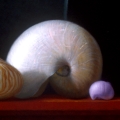Writer
William Swetcharnik is an artist and occasional writer. Twenty-five years ago, Swetcharnik wrote an art column, The View from my Easel, for a regional newspaper. Some of these columns focused on issues that artists face in their studio projects; others were reviews of museum exhibitions. Since then, Swetcharnik has continued the practice of writing essays based on his travels, museum visits, and art projects, with a view to eventually publishing them in a book of essays. Selected writings will be posted on this site.
Rembrandt's Late Religious Portraits
at the National Gallery of Art (March, 2005)
It is said that every portrait, in some sense, is a portrait of its maker.
Looking at Rembrandt's late religious portraits, one is struck by the similitude of his self-portraits to his paintings of the apostles. In one, he even poses himself as the Apostle Paul. Is he suffering from a surfeit of self-esteem? Not at all, so far as I can see. These seventeen images, brought together from museums around the world, are mostly of humble monks and saints facing suffering and in many cases, martyrdom. Sometimes the subjects are accompanied by the instruments of their impending death. In another portrait of the Apostle Paul, almost hidden in the brooding background, we descry the sword by which the old saint will shortly meet his end. Saint Bartholomew, who according to tradition was flayed alive, is twice shown with a knife. Was Rembrandt also identifying with Michelangelo's Last Judgment, in which that artist painted a self-portrait onto Saint Bartholomew's flayed skin? Indeed, self-examination and self-identification seems to be very much at play in Rembrandt's late religious art. Complete Rembrandt essay (March, 2005)
News from Las Pilitas, 4 November 1998
Sara and I would like to thank all who have expressed their concern about our well-being in Honduras. Thank God, we have been able to maintain a tenuous line of communication via a friend who has electricity and a phone line, where we set up our barely functioning computer. But we count ourselves fortunate to have food and shelter and a stream from which to fetch water. There are so many fallen trees there is no shortage of firewood for boiling the water. So not to worry: we are fine.
... I went down to the river. Walking out to the jagged end of the Puente Maillol I could see up the Segunda Avenida in Comayagüela, still submerged in water. On the right side of the avenue I could see the high water mark on the third floor of the Ministry of Education. Floating at my feet I could see some illustrated stories from the Miskito region that had been produced by a consortium of indigenous groups I have worked with. Complete news from Las Pilitas, 4 November 1998

